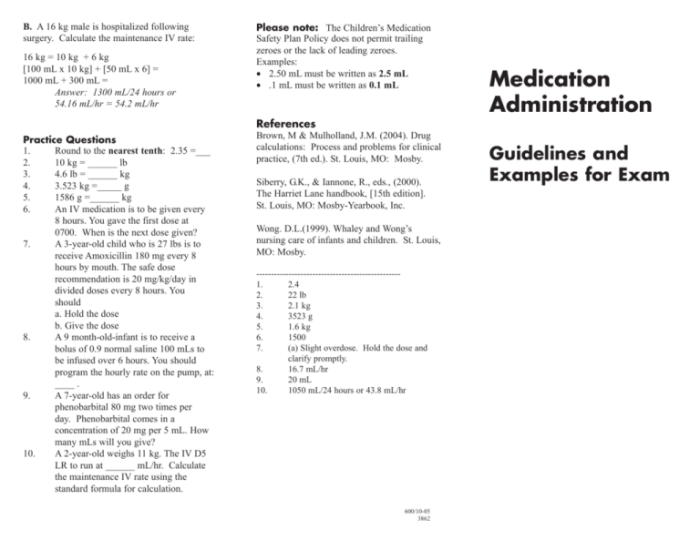Dosage Calculation 3.0 Medication Administration Test, a cutting-edge assessment tool, empowers healthcare professionals with the knowledge and skills to administer medications safely and effectively. This comprehensive guide explores the principles, methods, and techniques involved in dosage calculation, providing a solid foundation for medication administration practice.
Delving into the intricacies of dosage calculation, this discourse illuminates the challenges encountered in clinical settings and showcases how technology enhances accuracy. Moreover, it emphasizes the significance of medication administration tests, equipping readers with strategies to excel in these assessments.
Dosage Calculation Concepts: Dosage Calculation 3.0 Medication Administration Test

Dosage calculation is the process of determining the appropriate amount of medication to administer to a patient. The principles of dosage calculation include understanding the patient’s weight, height, age, and medical condition; the medication’s strength and dosage form; and the desired therapeutic effect.
There are different methods used for dosage calculation, including the body weight method, the body surface area method, and the nomogram method. The body weight method is the most commonly used method and involves multiplying the patient’s weight by the medication’s dosage per kilogram.
For example, if a patient weighs 70 kg and the medication’s dosage is 10 mg/kg, the patient would receive a dose of 700 mg (70 kg x 10 mg/kg).
Medication Administration, Dosage calculation 3.0 medication administration test
Medication administration is the process of giving medication to a patient. The steps involved in medication administration include assessing the patient’s need for medication, selecting the appropriate medication and dosage, preparing the medication, and administering the medication.
There are different routes of medication administration, including oral, topical, parenteral, and rectal. The oral route is the most common route of administration and involves taking medication by mouth.
Examples of medication administration techniques include giving a patient a pill, applying a cream to the skin, or giving an injection.
Medication Administration Test
A medication administration test is a test that is given to healthcare professionals to assess their knowledge and skills in medication administration. The purpose of a medication administration test is to ensure that healthcare professionals are competent in administering medication safely and effectively.
There are different types of medication administration tests, including written tests, oral tests, and practical tests. Written tests assess the healthcare professional’s knowledge of medication administration, while oral tests assess the healthcare professional’s ability to communicate with patients about medication.
Practical tests assess the healthcare professional’s ability to administer medication safely and effectively.
Dosage Calculation in Practice
Dosage calculation in clinical practice can be challenging due to a number of factors, including the complexity of medication orders, the use of different units of measurement, and the need to consider the patient’s individual needs.
Technology can be used to improve dosage calculation accuracy. There are a number of software programs available that can perform dosage calculations for healthcare professionals.
Dosage calculation errors can be prevented by following a number of steps, including double-checking calculations, using a calculator, and asking for help from a pharmacist or other healthcare professional.
Clarifying Questions
What is the purpose of a medication administration test?
Medication administration tests assess healthcare professionals’ knowledge and skills in administering medications safely and accurately.
What are the different types of medication administration tests?
Medication administration tests vary in format and content, including written exams, practical simulations, and online assessments.
How can technology improve dosage calculation accuracy?
Electronic health records (EHRs) and computerized physician order entry (CPOE) systems can reduce errors by automating calculations and providing alerts.


